We are experiencing yet another gun-buying spree (source, source, and source). Predictably, AR-15s are among the hotter commodities, along with 5.56/.223 ammunition. This might leave some of you wondering, is the Smith & Wesson M&P 15-22 worth having?
It’s available in many places and so is the .22 LR ammo to feed it. Should you buy one?
The answer, of course, depends. I will explain, but let’s start with the past.
Smith & Wesson M&P AR15-22 Backstory
Seizing on the system’s popularity, Smith and Wesson carved out a further niche to satisfy demand. During 2009, they introduced a .22 LR rendition of the black rifle. Their M&P AR15-22 was an instant hit. While made largely of polymer, it closely followed the lines of an AR-15. During 2011, I managed to get my hands on a few of these rifles for review.
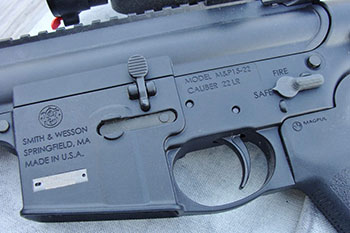
September 2020. While visiting a big-name sporting retailer, a friend observed shelves picked clean of centerfire ammo and defensively-oriented firearms. However, sitting in a rack behind the counter was a lone and fairly inexpensive AR. Closer examination revealed it to be a rimfire, S&W’s M&P AR15-22, configured as an MOE (Magpul Original Equipment) model.
For fans of the AR system, the M&P AR15-22 offers economical shooting possibilities. Connecting the dots, it’s safe to assume many shooters are sitting on large stashes of .22 LR ammo now. This could be because of everyone stocking up after the previous recent rimfire shortage. Scant inventories were snapped up with a fervor rivaling April 2020’s rush on toilet paper and hand sanitizer.
The incessant plague may deplete stocks of the latter two commodities, but many of us still have enough .22 LR rounds squirreled away to cover a decade of shooting. Putting the two-twos together, the timing seems right for another look at S&W’s M&P AR15-22.
Still wondering if the M&P 15-22 is worth buying? Let’s set the stage through 2011…
2011 Flashback. You’re prepared for the worst. You have a black rifle, several hundred rounds, spare magazines, and an assault case. You’ve bolted some accessories on to your AR-15 so that all contingencies will be covered. Drilling cans at 20 yards is fun. Tiny groups shot from sandbags at 100 yards are fulfilling.
But, how do these activities translate to the real reasoning behind your purchase? And, can you really afford to burn up several hundred rounds of .223 that quickly? Heck, do you even have access to a spot where that amount of noise will be tolerated?
Many AR targets perforated by 5.56 FMJs could as easily be punctured by lead rimfire bullets so, depending upon how often you shoot, a .22 LR version of your spiffy black rifle could conceivably pay for itself in short order. With some planning, it could even count as training. Worse case, it’ll provide lots of fun.
After getting the itch for a rimfire AR, I considered the three popular options:
- a drop-in .22 LR conversion unit,
- a dedicated .22 LR upper receiver assembly, and
- a complete .22 LR AR-15.
I opted for the latter when S&W introduced their .22 AR clone, and scored on an early-production specimen.
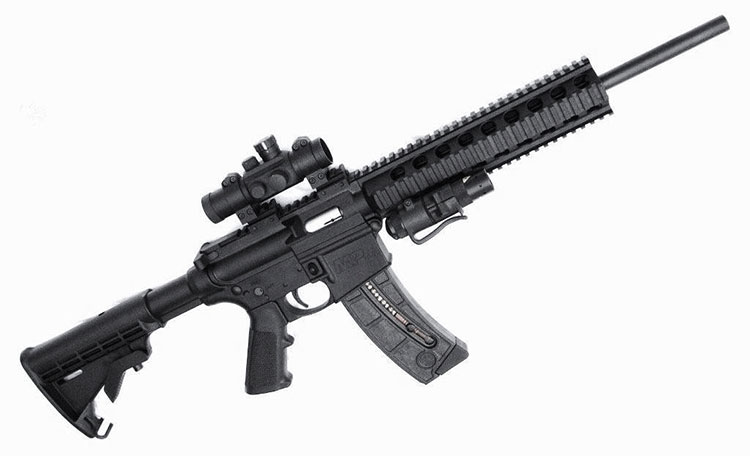
Cost wasn’t much higher than a dedicated upper and function was identical to the real McCoy, right down to a last-shot lock-back feature – a deciding factor for me. I was on auto-pilot during the first range session, thanks to its similar controls and design. The observations that follow are still relevant today.
M&P AR15-22 Functionality
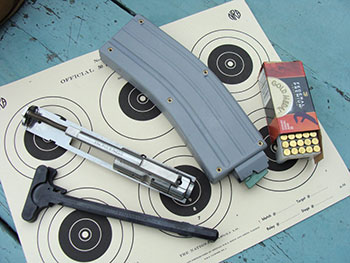
S&W’s .22 LR AR-clone is mostly polymer but does seem well thought out. It features a railed forend for accessories, a flat-top receiver, detachable (or folding) sights, a collapsible stock, and the same easy push-pin disassembly.
Cleaning is a snap thanks to a simplified bolt without a gas system, the same design used in AR .22 LR CMMG conversion kits. Two missing feature are the forward-assist and dust-cover. The buffer is also absent since its carbine-type “tube” is actually just a solid polymer stem. S&W designed the lower receiver so that it won’t accept any center-fire uppers; however pistol grips, triggers and after-market stocks will fit. In other words, plenty of latitude is available for customization.
Shortly thereafter, I bought my present S&W M&P 15-22, a somewhat upgraded MOE version with a MAGPUL collapsible stock, a MAGPUL pistol grip, and an A-2 flash-cage. I purchased this one in late 2001 used, but in like-new condition.
The initial test-fire was disappointing due to frequent stoppages which probably accounted for its bargain-price. This issue jogged my memory, prompting an internet search. Sure enough, this common problem popped up along with an easy fix.
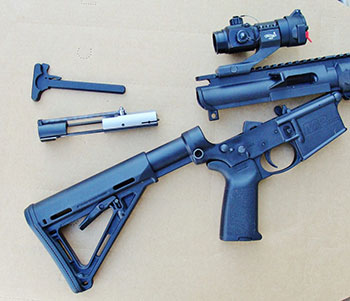
Turns out the ejector is a long thin steel blade which is largely unsupported and subject to bending. I’m guessing this one was bent a tad during a hasty cleaning session by its previous owner. The repair required just a few minutes, judicious use of needle-nose pliers, and some test shots in between. My ejector needed to be bent slightly inward, but others could require a vertical nudge.
Nine years and a bunch of ammo later, this S&W is still going strong. If starting with a new rifle, careful cleaning should prevent this problem.
Also, as received, the MOE’s GI trigger was typically rough and heavy, scaling over 7 pounds. Since justification for this purchase was based on economy, a $10 JP Yellow Trigger Spring was installed. Function remained reliable and the trigger pull improved. At 5 pounds it’s not match-grade, but it is much more shootable.
Shooting Results
Regarding accuracy, the nearly all-polymer construction didn’t inspire much confidence. Neither did my initial encounter involving the early-production version. Fortunately, the MOE did much better.
A spare Rock River one-piece scope base easily clamped onto the receiver and a Burris 1.75×5 1” scope was installed. At 50 yards, .22 LR 40-grain Federal Gold Medal Target consistently cut 5-shot groups of around an inch (my first example shot groups nearly twice that size at half the distance).
If ever there was a candidate for economical bulk-pack .22 LR rounds, this was it. Accuracy decreased somewhat, but was still plenty useful for plinking cans or fast-paced AR-type practice. I settled on Federal 36-grain HPs, sold in cartons of 550 rounds. They cut 5-shot groups closer to an inch at 25 yards; an acceptable compromise given that they tend to go downrange in large quantities.
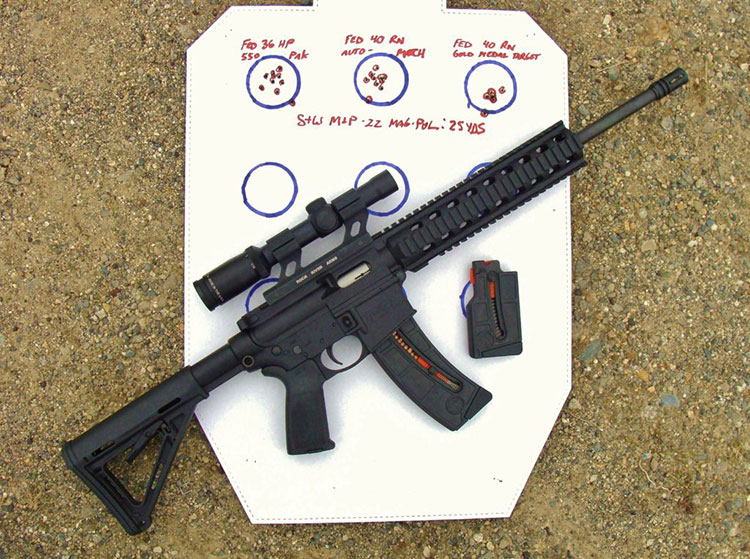
Later on, the scope was exchanged for an inexpensive Walther dot-sight and a spare battery was stowed in the grip compartment. A Safariland RLS light was slipped onto the left forend rail. Turns out this combination is near-perfect for repelling four-legged invaders (skunks, etc.) after dark. I just leave the light attached to the forend with a 25-round magazine full of Federal HPs nearby.
The little S&W with its familiar manual-of-arms has also turned into a spare “bump in the night” gun. Yeah, I know, it’s a .22 – but it holds 25 shots and I won’t be blind or deaf if I need to touch it off. By the way, extra 25-shot magazines are affordable, but they can be fiddly to load.
Shooting off sandbags proved difficult because of their length. They contacted the bench, but a shorter 10-shot magazine solved that problem nicely. S&W uses a proprietary design rather than the Black Dog Machine version employed by others.
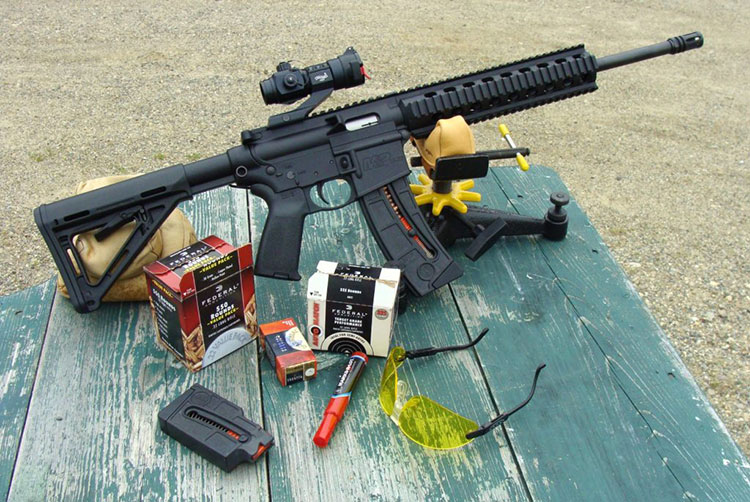
The M&P AR15-22 Today
S&W’s current AR15-22 Sport MOE SL now features a MAGPUL MOE SL (Slim Line) Stock, and a slimmer forend designed for the popular M-LOK system (fillers and a mounting plate are included). You can shop various configurations right here.
My original non-folding iron sights were removed when tinkering with optical options, however the current model ships with MBUS folding sights. The MOE SL is configured as a carbine with a 16 ½” barrel, weight is advertised as 78.9 ounces. However, S&W now catalogs around 20 AR15-22 versions, including some package-guns with dot-sights or scopes, plus a couple pricier Performance Center models.
Interesting Possibilities. A very useful AR feature involves its near-instant tool-less take-down. After pulling both receiver pins, the disassembled rifle will fit in a pack or spotting scope case, etc. for compact transportation.
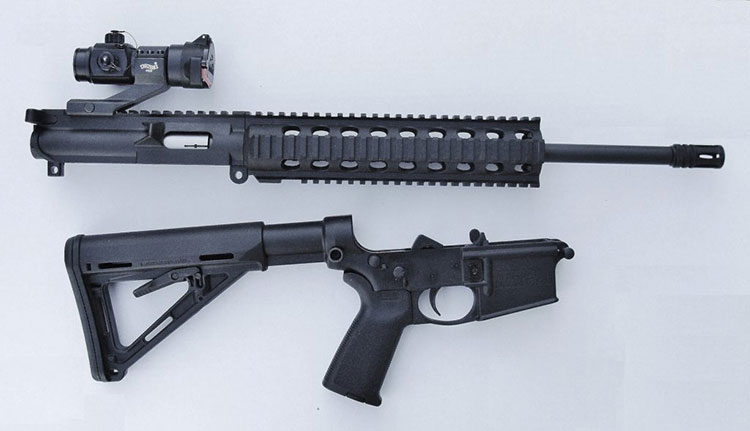
By adding a brick of ammo and a few spare magazines, you could have a very compact and portable subsistence package. My IR illuminator and night scope also mounted without difficulty, raising interesting possibilities for nocturnal action.
Those M&P AR15-22s (most versions) with threaded muzzles will accept common 1/2x 28 devices which, of course, opens a gateway to suppressors. When fired through a silencer, .22 LR subsonic loads are extremely quiet!
It’s worth noting that the .300 Blackout has caught on due to the same AR advantage. And, beyond quiet subsonic loads, this cartridge offers enough .30-caliber punch for use on deer or hogs. When placing identically-configured .22 LR and .300 BLK ARs side-by-side, further benefits become apparent. Their stocks will adjust to fit anyone, and recoil is a non-issue.
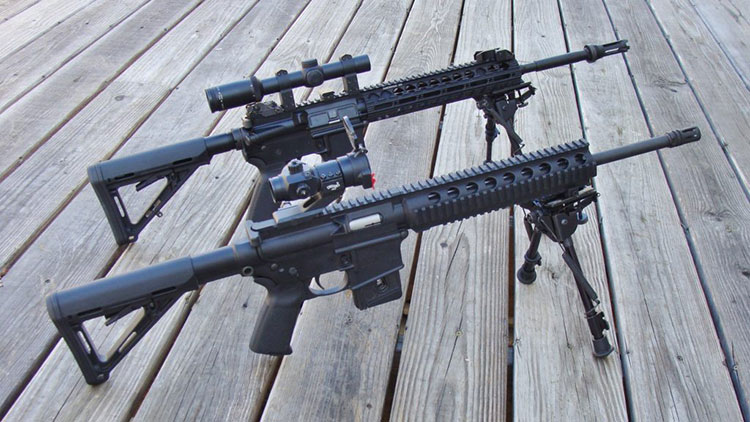
Although perhaps a bit unorthodox, this kind of two-gun AR system could be just the ticket for younger or smaller-statured shooters. Some (including myself) will argue a bolt-action is the better beginner’s choice, but then again, lots of new shooters started with Ruger 10/22 semiautos.
M&P15-22 Consumer Safety Alert. A lingering issue is a recall that affects AR15-22s made before Feb 1, 2019. Although supposedly rare, Smith-Wesson.com says some bolt faces were machined with shallow recesses. The result can be one, or even multiple (full-auto) slam-fires, as a cartridge is chambered. This can occur regardless of trigger contact or the safety’s position.
Upon request, Smith & Wesson will mail a simple gauge (really just a plate) that slips under the extractor into the bolt face. If it sits flush or slightly below, the gun is fine. If the surface of the gauge stands a bit proud the bolt is unsafe, in which case it can be returned to S&W for a free replacement.
I surfed the web in hopes of discovering a reliable gauge-thickness but (of course) the posted measurements were inconsistent. My bolt-face recess is about .036 and, so far, it has worked just fine.
Is the M&P 15-22 Worth Buying?
Crunch the numbers to determine whether a .22 AR-15 is worthwhile. You won’t stay sharp if you don’t shoot, and a rimfire clone just might pay for itself if you do.
Occasionally, I’ll bring a brick of .22s to the range and run through a 100-yard AR qual-course, or some CQB drills. Steel reactive targets get peppered without concerns over high-velocity damage. This fun transfers nicely to centerfire disciplines thanks to the S&W’s identical features.
Today, the list of rimfire AR manufacturers has expanded. My polymer S&W does the job without breaking the bank, but more substantially-built examples are available for greater costs. Customization is another option for those into toys. The recent action-shooting developments that sparked 9mm AR carbine interest have spilled into .22 rimfire ARs. Thus, the S&W now serves as a foundation for a growing list of accessories available online.
The AR addiction never really ends…

4 comments
My oldest daughter and now my oldest grandson work or have worked at the state prison near here. Both have to qualify with an AR15, a 12 gauge shotgun, and an N-frame .357 Magnum (w/38 Specials). My daughter was have a hard time qualifying with the AR. And 2 experienced shooters were having trouble discovering what the problem was. I was a vendor at a gun show and got offered an M&P AR 15-22 with a number of magazines. We spent probably $60 in .223 ammo (a couple hundred rounds then); for $15 of 22 LR we figured out her problem and had her shooting 5″ groups off hand at 25 yards, which was good enough for the job.
All that to say this, I have used the 22 conversion kits, and most work okay. With this rifle you can practice with younger shooters and inexperienced shooters, set it up just like a .223, and for me the set up was actually less than a regular .223 plus a conversion kit. And you can practice all the same drills as you would with a .223 (it’s difficult with the conversion kit). Conversion kits are running about $225+ dollars and include 3 mags. Also, conversion kits require a different/additional maintenance than a .223 to keep them from “failures to feed and eject” due to carbon buildup in a different place than a .223. 22 LR is also dirtier than .223.
All things considered, if it is just you or you and a spouse, I might just stick with the conversion kit. With more than 2, I’d go with the AR 15-22.
Having fun since 2003 with my first AR15, the bug never stops and am re-enjoying the 22lr again. My Ciener conversion kit was very fussy and disappointing at first, but now with the ONLY ammunition (Rem. ThunderBolts) works flawless. The ejector hook on the right wouldn’t line up smoothly when chambering and needed to be ground down a little.
This is a blast with a Franklin Binary 3; (not the 10/22) on a pistol upper and suppressor.
Even with a 1/9 twist .223/5.56 7″ barrel at 100yards with steel targets are 2moa!
Cheap fun
looking for a scope for my 15-22 Smith and Wesson
Charles Blodgett:
Try a Nikon P-22. It is made for the 22 LR and is a full-sized scope.